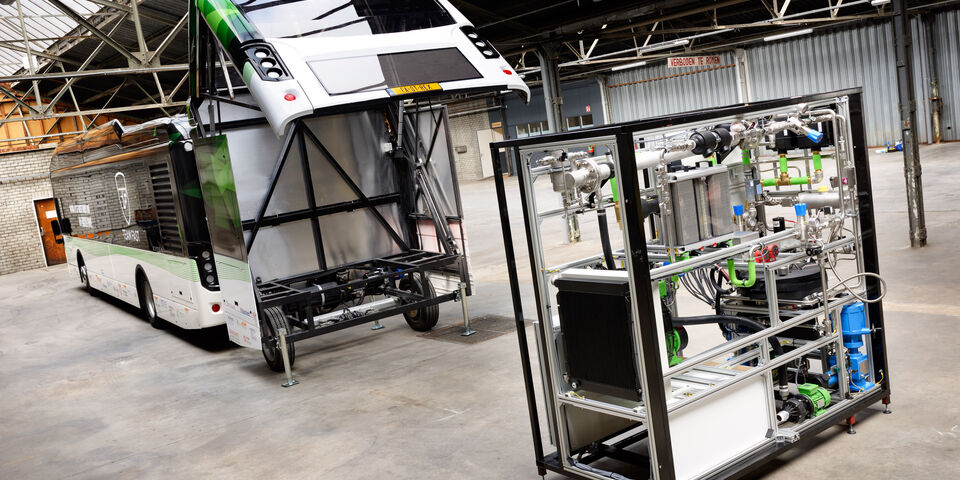Team FAST presents range extender on formic acid REX
TU/e team FAST will this afternoon, Thursday July 6, present REX, a system which converts formic acid into electricity, and which can be linked to an electric bus as a range extender. REX can provide an electric power of 25 kilowatt – 42,000 times more than scale model Junior, which was presented early last year by the student team from Eindhoven.
Sponsor and bus builder VDL has made an electric city bus available to Team FAST, which has been fitted out like an exhibition room for the presentation on the VDMA site at Vestdijk in Eindhoven. In the exhibition a timeline is used to sketch the history of the student project and there is a tablet showing films that explain how the formic acid technology works. In addition, the earlier vehicles of the team running on formic acid, which are named Pico and Junior, are on display in the bus.
A trailer has been linked to the rear end of the bus, which accommodates REX: a kind of miniature power plant on the basis of a so-called reformer in which liquid formic acid is split into carbon dioxide and hydrogen. The hydrogen subsequently functions as fuel for a fuel cell, which provides the power for the electric propulsion of the bus. That electric bus is not running on formic acid yet, for that matter: although the reformer has meanwhile been completed and only needs to be subjected to a number of tests, the fuel cell is not in use yet.
Still, Yela Weitkamp, ‘Chief Chemical’ of Team FAST, emphasizes that the reformer is the unique component of the system presented. “The rapid conversion of formic acid is the innovative step that makes it possible for a bus to run on formic acid.” By contrast, the fuel cell, as he explains, is a technology that has already proved itself. For REX the team did decide on a sophisticated type of fuel cell, which is able to deal with the presence of carbon dioxide.
After all, conventional fuel cells cannot cope with impurities in the hydrogen provided, Weitkamp explains. “This is why in our previous prototype, Junior, for example, the CO2 leaving the reformer was filtered out of the gas mixture. That will no longer be necessary when we have the new fuel cell, which will need to be linked by next year’s team.” The intention is for the VDL bus effectively to run on formic acid before the end of the year.
Not compact
The current system has a size of approximately four cubic meters, so it fits snugly in the trailer designed for it. Admittedly, this did take some efforts, as it turned out on Wednesday when this move was tried by means of a fork-lift truck in preparation for the presentation . “At VDL we already tested it in the trailer earlier, but there they have a convenient transport system for this”, Weitkamp explains.
REX was never designed to achieve ultimate compactness, by the way: for a first prototype it was more important that all the different components could be reached easily. Weitkamp expects that the next version can be considerably smaller. “And perhaps we can even dispense with some superfluous parts.”
Formic acid - or hydrozine, as Team FAST prefers to call the energy carrier – boasts the advantages of being safe, liquid and sustainable (CO2-neutral). That last-mentioned quality only applies, for that matter, when the hydrozine is produced by means of sustainably generated energy with CO2 captured from the air or from waste streams. This is why team FAST is also taking part in a new project, Power-2-FA, which is intended to develop a sustainable production method for formic acid. Other participants involved in this project, which is led by TNO (Netherlands Organization for Applied Scientific Research), include Delft University of Technology and Mestverwerking Friesland (a manure processing firm).


Discussion